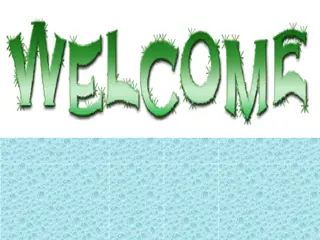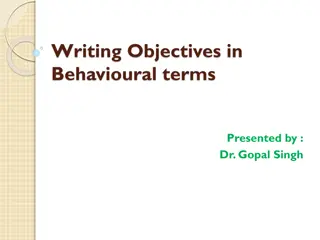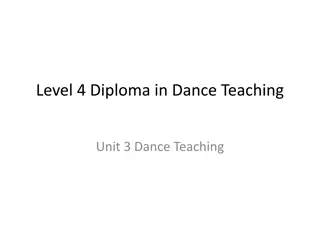Exploring the Role and Objectives of Laboratory Teaching
The content delves into the various perspectives on laboratory teaching, its aims, pedagogical levels, and common challenges faced. It discusses specific aims of laboratory teaching, including familiarization with equipment, teaching experimental work attitudes, and training in observation and deduction. The classification of objectives into teaching experimental methods, supplementing lectures, and incidental aims is also explored. Additionally, it covers Bloom's taxonomy of objectives in the cognitive domain and cognitive levels related to laboratory teaching.
Download Presentation

Please find below an Image/Link to download the presentation.
The content on the website is provided AS IS for your information and personal use only. It may not be sold, licensed, or shared on other websites without obtaining consent from the author.If you encounter any issues during the download, it is possible that the publisher has removed the file from their server.
You are allowed to download the files provided on this website for personal or commercial use, subject to the condition that they are used lawfully. All files are the property of their respective owners.
The content on the website is provided AS IS for your information and personal use only. It may not be sold, licensed, or shared on other websites without obtaining consent from the author.
E N D
Presentation Transcript
Organization Role of Laboratory Teaching How various persons see it Aims of Laboratory Teaching Pedagogical levels Major Problems What can be done A Typical Laboratory Exercise Design of one course Experimental Aerodynamics 2 2
Common Complaint Bookish - not practical enough Standard Solution offered: Increase Practicals - which means Lab classes 3
How they view labs Teachers Students Administrators Education planners 4
Specific Aims FAMILIARISATION with standard equipment measuring technique ILLUSTRATION of physical phenomenon concepts taught in lectures TEACHING of attitude to experimental work 5
Specific Aims TRAINING in observation deduction from observations critical awareness keeping lab notebook writing reports experimental design acquiring specific information PROVIDING closer contact with faculty stimulation for independent thinking feel for R&D labs 6
Classification These objectives can be classified in three categories: Teaching experimental methods (EM) Supplementing lectures (SL) Incidental aims (I) 7
Blooms Taxonomy of Objectives in the Cognitive Domain 1. Knowledge 2. Comprehension 3. Application 4. Analysis 5. Synthesis 6. Evaluation 8
Cognitive Levels FAMILIARISATION with standard equipment measuring technique 1 1 EM EM ILLUSTRATION of physical phenomenon concepts taught in lectures 1 1 SL SL TEACHING of attitude to experimental work - EM 9
CognitiveLevels TRAINING in observation deduction from observations critical awareness keeping lab notebook writing reports experimental design acquiring specific information PROVIDING closer contact with faculty stimulation for independent thinking feel for R&D labs EM EM EM EM EM EM EM 1 2 ~ 3 3 ~ 4 1 - 4 1 I I I - ? - 10
Exhibit 1 Strain gauges Time taken? What are they learning? 11
Exhibit 2 12 12
What are we trying to teach? Follow recipe Results in reduction exercise a numerical problem with realistic data 13
ConflictingAims Reinforce Lecture Material Teach Experimental Method large number of experiments detailed instructions long time needed for experiments self discovery 14
Abdulwahed-Nagy Constructivist Laboratory Model Based on Kolb s Experiential Learning Cycle 15
Abdulwahed-Nagy Constructivist Laboratory Model 16
The Issue Why does an engineer undertake an experimental investigation? For obtaining design data To verify that the designed object meets the performance objectives 17
Major Problems with current design of labs Vital aspects such as selecting or devising the apparatus, what measurements to be taken, what variables need to be controlled are not addressed to by the students. How the tests have to be conducted and how the accuracy has to be estimated is also not in the control of students. Students are not given the opportunity to think for themselves. 18
What is needed? Deciding what needs to be measured deciding what sensors and instruments to use Configuration of sensors and instruments 19
Extended Discretionary Laboratory Teaching (EDLT) 1. An objective or a task usually given in one sentence, sometimes as a question. 2. A very brief guide in a two or three sentences as to the major direction to take, 3. Resources available which may include definitions, special techniques, materials, references, parameters, or other information needed to fulfil the objective or complete the task. 20
A course in Experimental Aerodynamics Two 1-hr lectures + One 3-hr lab a week Lecture contents: Principles of experimental design Hypothesis formulation & testing Error estimation Problems of measurements and validation Similitude + subject-specific techniques 21
Lab Programme About 10 experiments posed with a minimum of instructions Students experiments about the given equipment and chose the necessary uniquity parameters making sure that the modelling range is as required for the phenomenon. are expected to plan their 22
General Instructions General Instructions You are required to complete a set of experiments as detailed below. A new strategy is being attempted this term in which only the broad goal of each experiment is given to you. You will be required to plan your experiment around the equipment being made available to you. For best results you are advised to study the available equipment before the date of experiment, and to talk to the instructor. Make sure you understand the range of physical variables available to you for control and to plan your experiment in details before you come to the lab for experiment. Discuss your plan with your instructor before you begin. He may suggest modifications or he may not, depending upon his judgement as to the learning value of any mistakes that you might make. 23
General Instructions This strategy has been adopted in the hope that it will offer you more control of the decisions that need to be made in any experimental investigation and that it may lead to a more efficient learning about the experimental method, which is seen as one of the more important learning objective of the course Planning of an experiment requires fixing the values of the various parameters that control the experiment: speeds, diameters, angles of attack, etc. These are usually fixed depending on the range of non- dimensional similarity variables of interest. Therefore the first thing that needs to be done while planning experiments is to determine the range of control parameters available to you, and then decide the values that you are going to use so that the similitude parameters are within the desired range. 24
Revised Experiment of Exhibit 1 Convert the given ring of metal into a load cell and calibrate it. 25
Revised Experiment 2 A TYPICAL REVISED EXPERIMENT DETERMINING AEROFOIL SECTION PROPERTIES USING PRESSURE AND VELOCITY MEASUREMENTS To determining appropriate properties of an aerofoil section using surface pressure measurements and wake survey. The basic information from which all aerodynamic section properties can be evaluated in the pressure distribution around the profile. In this experiment, use the appropriate pressure taps to measure the pressure distribution around an aerofoil and then calculate the section properties. The section drag coefficient will be in error. Why? We can use momentum defect to measure the drag coefficient. Do this. Learning Objectives: Use of 2-d wind tunnels. Calculation of section properties using measured pressure data. Presentation of sectional data. Use of wake momentum rake. 26
Incidental Aims Report writing Oral presentation Use of presentation software 27
Incidental Aims In addition, each student is expected to submit TWO experiments written up as formal reports, as communications to a technical journal. Format specified for the technical notes in the AIAA Journal is to be followed. This would count for 20 points. if they were 28
Design of Lab Courses Lab experiment should not be laid out completely. There must be decisions that a student has to take. The purpose of an experiment in a lab course is to teach a student the experimental method. For this purpose, give minimum of directions. The student should gain control of the decisions that are made while conducting experiment. The student should choose the uniquity parameters of the experiment. 29
Design of Lab Courses Experiments should not be just demonstration, or verify the law type. Must involve collecting data for design, or testing a prototype to verify if it meets the specs, or investigating a new situation. Error analysis, up to and including calculation of error bars should be essential requirement for each experiment. Each experiment should be so designed that it takes up the full assigned time. 30
Design of Lab Courses Student should be taught how to keep a lab record book. We should not require students to write up reports on each experiment. For most experiments it should be the lab record book that should suffice. We can and should teach student technical communications in lab courses. This may be done by asking students to write up some experiments (one or two) as a Technical Note to a standard Journal using the format specified by that Journal. 31
Thank you 32























